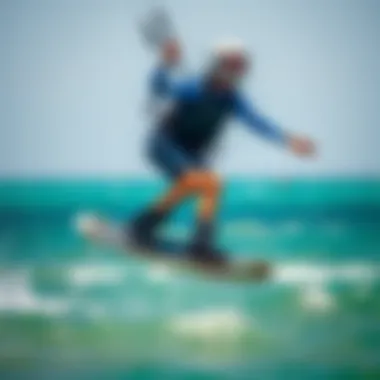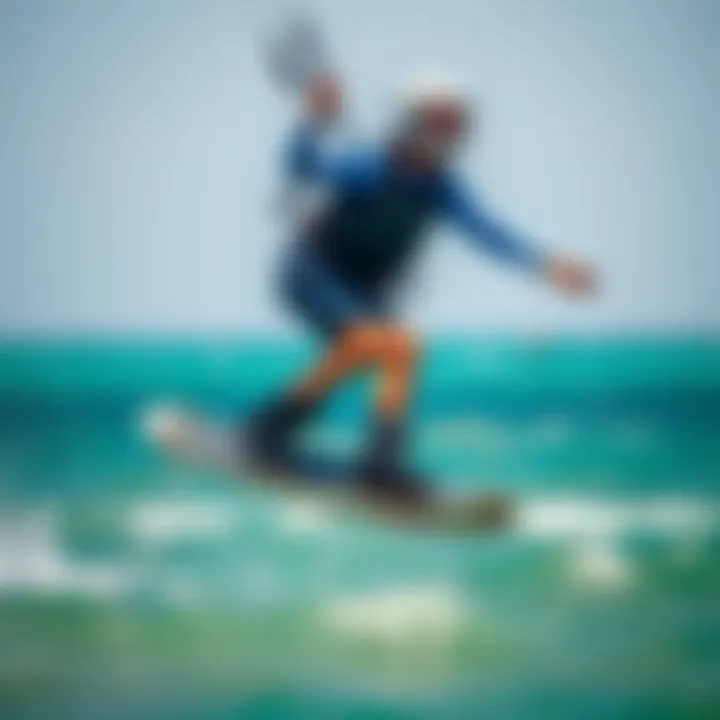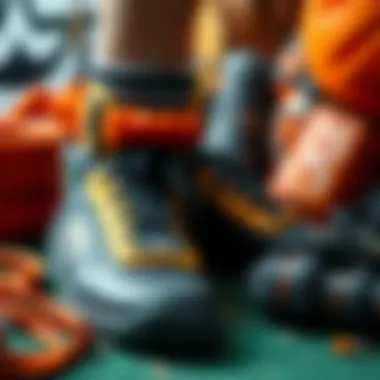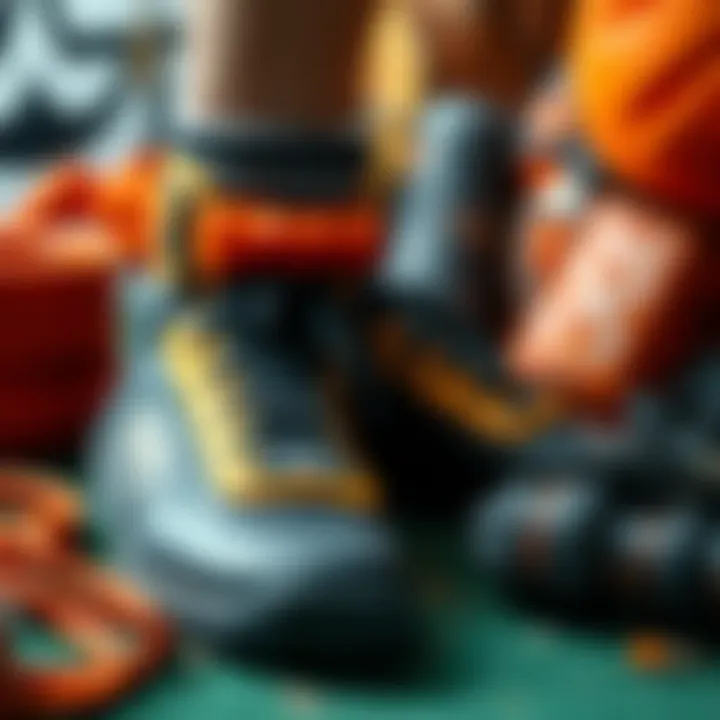Exploring the Benefits of Toe Split Boots for Kiteboarding


Intro
In the vibrant world of kiteboarding, where the wind and water converge to create exhilarating experiences, having the right gear can make or break your ride. Among the many innovations in this thrilling sport, boots with a toe split design have risen to popularity, promising kiteboarders improved performance and comfort. These specialized boots allow for greater foot movement, impact absorption, and grip, contributing to a more responsive ride. This article delves deep into the essential attributes of toe split boots, shining a light on their functional aspects, material choices, and everything in between.
The demand for precision and control in kiteboarding has paved the way for advancements in design and technology. If you're a kiteboarder—whether just starting out or a seasoned pro—understanding the advantages of these boots can directly impact your performance on the water. Throughout this article, we'll uncover critical insights into toe split boots, examining their construction, how they cater to various skill levels, and enhancing your overall kiteboarding journey.
Equipment Insights
Latest Gear Reviews
When it comes to toe split boots, not all are created equal. The market is flooded with options, each offering unique features that could be advantageous depending on one's skill level and riding style. Notable brands like Mystic, Naish, and Cabrinha have introduced some innovative models that stand out. For example, Mystic's MK8 series is known for its superior ankle support and precision fit, enhancing maneuverability.
- Mystic MK8: Renowned for adjusting snugly around the ankle, this boot ensures minimal slippage during jumps.
- Naish Motion: This boot combines a split toe with lightweight material, allowing for better foot control.
- Cabrinha Aura: Excellent for advanced riders, it offers impressive grip and durability in rough conditions.
Before purchasing any pair, it's wise to consider your riding style—agility-focused or stability-oriented—and read reviews that align with your preferences.
Essential Gear Maintenance
Proper maintenance of your toe split boots is crucial for long-lasting performance. Treating them right extends their life and keeps them performing at their best. Here are some practical tips to ensure your boots remain in excellent condition:
- Rinse After Use: Always rinse your boots with fresh water after a session. Saltwater and sand can lead to premature wear and tear.
- Dry Properly: Avoid placing boots in direct sunlight or on heaters, as excessive heat can distort the material. Air dry them indoors instead.
- Inspect Regularly: Check for any signs of damage, especially around the toe split, as this is a common wear point. Address minor issues before they escalate.
Maintaining these boots may seem menial, yet it's an essential practice that pays off in terms of performance.
Technique Exploration
Beginner Techniques
Getting comfortable using toe split boots can take some practice. Here are a few techniques that beginners should master:
- Foot Position: Ensure your foot fits snugly in the boot. Practice moving the board heel to toe to develop better balance.
- Weight Distribution: Adjust your weight between heels and toes—this responsiveness aids when navigating tricky waters.
- Kiting Stance: Maintain a proper kiting stance, bending your knees and engaging your core, which enhances control during turns.
Ideal practices ingrained early on can lead to more enjoyable sessions.
Advanced Maneuvers
For those seasoned in kiteboarding and aiming to refine their skill set, toe split boots unlock advanced techniques. Experienced riders can benefit from:
- Dynamic Turns: Utilize the agility granted by toe split boots to perform tighter turns with less effort.
- Jump Techniques: Engage your toes independently to adjust your weight and angle during aerial maneuvers.
- Slide Tricks: Use the nimbleness of your feet to execute slides and grabs, adding flair to your performance.
These advanced maneuvers depend largely on the boots' ability to enhance foot movement and responsiveness.
"The right gear can transform your kiteboarding experience, allowing you to feel at one with the water and wind."
This article aims not only to inform about the technicalities of toe split boots but also to inspire kiteboarders to elevate their game. By exploring design influences, performance enhancements, and maintenance practices, individuals can optimize their gear, improving both safety and enjoyment in each session.
Prolusion to Boots with Toe Split
In the world of kiteboarding, equipment choice can sometimes make or break a ride. Among the myriad of gear available, boots with a toe split design stand out, not just for their unique aesthetics but for their functionality too. These boots serve a purpose that goes beyond just fitting on your feet; they can enhance performance, improve rider comfort, and offer a level of adaptability that traditional footwear might lack.
"The right gear can elevate your experience from ordinary to extraordinary."
Understanding the role of toe split boots can empower both beginners and seasoned kiteboarders to make informed decisions tailored to their skill levels. The introduction of such designs into the market has sparked conversations about how innovation can directly affect performance and safety while out on the water. It's important to navigate through the historical context and evolution that brought these boots into the spotlight.
Historical Context
The history of toe split boots dates back to the early days of extreme sports when riders began to recognize the need for improved grip and flexibility. Back then, the options were pretty limited, often leading to awkward rides as riders struggled with their equipment. It was during this time that some innovative kiteboarders began to experiment with boot designs that would allow more freedom of movement without sacrificing the stability essential for control.
As the sport evolved, so did the boots. Initially crafted from rigid materials that stifled movement, manufacturers took heed of rider feedback, leading to modifications in materials and split designs. The introduction of neoprene, for instance, played a pivotal role in offering not just comfort but also water resistance. Different brands began competing to create the most functional toe split boots, each iteration improving on the previous, gradually incorporating elements that promoted agility and performance.
Evolution in Design
Fast forward to today, the design of toe split boots has come a long way. Modern designs have integrated advanced materials and technologies to cater to the evolving demands of kiteboarders. For instance, many manufacturers now utilize lightweight, durable fabrics that make the boots feel almost non-existent while riding. This evolution isn't just surface-level; it's rooted in a deep understanding of biomechanics and the specific movements involved in kiteboarding.
Several prominent design features have emerged over the years:
- Flexibility: The split design allows for enhanced toe movement, enabling riders to have more control over their foot positioning on the board.
- Secure Fit: Adjustability options have also improved, with many brands now offering multiple fastening systems that not only provide a snug fit but also allow for quick adjustments in varying conditions.
- Foot Support: Structural reinforcements have been built into many designs to provide necessary arch support, reducing fatigue during long sessions on the water.
Understanding these developments is critical for kiteboarders looking to optimize their performance and ensure their safety on the water. As the designs continue to innovate, the prominence and utility of toe split boots are likely to grow even further within the kiteboarding community, making it an essential aspect of gear discussion among enthusiasts.
Understanding the Functionality
When it comes to kiteboarding, having the right gear can mean the difference between an average day and an exhilarating adventure. One pivotal aspect of this gear is the toe split design in boots, and understanding its functionality is crucial for maximizing performance on the water.
The toe split feature essentially separates the big toe from the rest of the foot, akin to how a glove fits snugly around fingers. This design delivers several advantages that cater directly to the needs of kiteboarders.
The Mechanics of Toe Split
In essence, the mechanics behind the toe split relate to enhancing agility and control. Traditional boots often restrict the movement of the toes, making it difficult for riders to execute sharp turns or maintain optimal balance. The toe split allows for greater mobility, meaning each toe can adjust independently to shifting weight and pressure.
When the wind gusts or waves catch a kiteboarder off guard, the ability to maneuver swiftly is essential. With a toe-split boot, riders can engage their toes more effectively, leading to quicker reactions and better control of the board. Instead of feeling like you're trapped in a rigid shell, these boots feel like a natural extension of your body.
The benefit of having a toe split is like finding that extra gear in your car—it allows for smoother acceleration and sharper handling when you need it the most.
Benefits for Kiteboarders
The benefits of toe split boots resonate on multiple fronts:
- Enhanced Control: The responsiveness you feel is like a musician hitting the right notes effortlessly, allowing for precision maneuvers.
- Improved Agility: With independent toe movement, quick adjustments become second nature. This is especially useful in tricky waters where conditions change rapidly.
- Boosted Comfort: Riders often find less strain on the foot. Comfort goes hand-in-hand with performance—if your feet feel good, you can focus on your skills rather than discomfort.
For many kiteboarders, these boots essentially open a new realm of possibilities. They help in executing tricks that might have seemed out of reach while keeping the overall experience enjoyable and less fatiguing. While some may think these boots are just a fad, their functional benefits provide a solid answer to the needs of both beginners and experienced riders alike.
In summary, the toe split functionality significantly contributes to better performance in kiteboarding. Understanding this element not only helps in making informed decisions regarding equipment but also enhances the enjoyable experience on the water. With a solid grasp of the advantages stemming from the mechanics of these boots, kiteboarders can elevate their game, whether they are just starting out or are seasoned practitioners.


Material Considerations
When diving into the world of toe split boots, understanding the materials used in their construction is pivotal. The choice of materials not only impacts performance but also dictates comfort, durability, and responsiveness on the water. Kiteboarding demands a lot from gear, and the right synthetic fabrics and composites can make a world of difference. Employing top-notch materials can enhance the rider's overall experience, ensuring both longevity of the equipment and safety during instances that push the limits.
Common Materials Used
Toe split boots generally leverage high-quality materials tailored for performance in aquatic environments. Here are some of the most prevalent materials found:
- Neoprene: Soft, stretchy, and waterproof, neoprene provides insulation while allowing for flexibility. It forms a snug fit around the foot, minimizing excess movement.
- PU (Polyurethane): Decking made from PU is sturdy yet less bulky than traditional materials. It can endure saltwater and UV exposure without deteriorating rapidly.
- Cordura Fabric: Known for its durability, Cordura resists abrasions, making it ideal for the rigors of kiteboarding. It stands tough against the occasional scuff on rough surfaces, like those jetties or rocky shores.
- Thermoplastic Rubber (TPR): This is often used in the outsoles. TPR offers grip and traction, crucial for maintaining control when maneuvering on the board.
The integration of these materials not only enhances functionality but also helps in creating a lightweight product that does not compromise on strength. For kiteboarders who seek both comfort and a performance edge, these material choices are worth scrutinizing.
Durability and Performance
The durability of toe split boots directly correlates with the quality of the materials used therein. Boots crafted from premium materials, such as high-grade neoprene and robust PU, offer significant advantages:
- Resistance to Wear and Tear: Regular exposure to saltwater, sand, and sun can wreak havoc on lesser materials. Boots that are constructed with durable fabrics tend to withstand these forces better, ultimately resulting in lower costs over time due to less frequent replacements.
- Enhanced Performance: Durability impacts performance quite directly. When boots hold up well under pressure, kiteboarders can push their limits without fearing equipment failure. This reliability builds confidence, improving overall control and agility on the water, allowing riders to focus more on skill rather than gear limitations.
- Safety Considerations: Sturdy boots don't just last longer; they also better protect the rider's feet. A well-constructed boot can avoid injuries that might occur from impacts with the board or rough surfaces during a trick or fall.
In sum, selecting toe split boots made from durable materials is not just a matter of preference but necessity for anyone serious about kiteboarding. It's an investment in one's safety and performance on the water, paving the way for greater experiences and adventures.
“The life of your gear is only as good as the materials in its making; don’t skimp on quality.”
Whether to improve comfort through smart material choices or boost the lifespan of your gear, understanding these material considerations is crucial for every kiteboarder.
Comfort and Fit
Comfort and fit are paramount when it comes to choosing boots with toe split designs, particularly for kiteboarders who need both performance and safety while riding the waves. The dynamics of a kiteboarder's movement can significantly impact their experience, and having the right footwear can make all the difference. Well-fitted boots, paired with thoughtful design features, offer better control, responsiveness, and confidence, allowing riders to push their limits without worry.
Importance of Proper Fit
A proper fit is not just about choosing the right size; it can dictate the entire kiteboarding experience. When boots fit snugly without being too tight, they promote better control over the board and increase sensitivity to changes in water conditions. The advantages include:
- Improved Sensitivity: A well-fitted boot provides direct feedback from the board to the rider. This feedback loop helps riders anticipate movements and adjust their balance more effectively.
- Increased Safety: Ill-fitting boots can lead to foot fatigue and increase the risk of injuries. A tight or loose fit can cause blisters and other discomforts that can spoil the fun.
- Enhanced Performance: Riders who wear properly fitted toe split boots often notice improvements in their agility and maneuverability. This is especially important for those looking to master tricks or navigate challenging water conditions.
Adjustability Features
Adjustability is another beacon that shines in the realm of comfortable footwear, especially in toe split boots. Manufacturers often equip these boots with several features designed to help riders tweak the fit to their preference. Such features include:
- Lacing Systems: Many boots come with advanced lacing systems that allow for precise adjustments. Riders can tighten or loosen specific areas of the boot based on their personal comfort or the demands of their riding style.
- Strap Systems: Some brands incorporate double straps that secure the foot in place while allowing for individual adjustments over the ankle and toe. This dual-action can be crucial for maintaining a secure feel while riding.
- Customizable Insoles: A few high-end boots provide removable insoles that can be swapped out for custom ones, catering to foot shapes and preferences. This adds yet another layer of comfort and support.
"Finding gear that fits well can change the game entirely, especially when speed and maneuverability matter."
With a focus on comfort and adaptability, riders can spend more time on the water and less time worrying about their gear. The intersection of fit and comfort enhances not only performance but also enjoyment, a crucial aspect for both novice and experienced kiteboarders. Whether one is just starting or looking to take their skills to the next level, understanding the nuances of comfort and fit in toe split boots can have a profound impact.
Performance Enhancements
Performance enhancements in boots with toe split designs are not just marketing jargon; they are core to elevating the kiteboarding experience. The mechanics behind these enhancements translate into tangible benefits for riders, impacting their ability to maneuver on water and handle varying conditions. Understanding this facet can drastically influence how kiteboarders perceive their gear and push their limits.
Agility on Water
When it comes to kiteboarding, agility is the name of the game. Boots with toe splits allow riders to flex their feet in a way that feels as if they are barefoot. This design helps in achieving better movement response, letting the rider shift their weight and pivot more efficiently. It’s a bit like dancing on water; the more flexible your gear, the smoother your moves.
- Foot Positioning: The split design permits your toes some wiggle room, enhancing natural feel and responsiveness to board input. This means quicker adaptations to the water's surface and improved balance.
- Reduced Drag: A streamlined profile aids in minimizing water resistance. It’s simple physics – less drag equals more speed. Increased speed contributes to a thrilling ride; every kiteboarder knows that feeling of wind whipping past while cutting through the waves.
For instance, when a rider is out in choppy waters, the ability to shift weight from heel to toe facilitates sharper turns and quicker recoveries from wipeouts. Feet can act almost independently, allowing for nuanced movements that give serious edge in competitive scenarios.
Control in Varied Conditions
Having control in diverse conditions can make or break a kiteboarding session. As every kiteboarder knows, conditions can change from calm to chaotic in the blink of an eye. Boots with toe splits provide riders with the ability to better adapt to such fluctuations.
- Enhanced Grip: The interaction between the toe split and certain types of foot straps effectively amplifies grip, providing a more secure foothold. Whether it's windy or calm, being anchored to the board gives riders the confidence to push harder and explore the limits of their abilities.
- Increased Ankle Mobility: The unique toe split design fosters greater ankle mobility than traditional boots. This means that when the wind suddenly picks up or waves turn rough, riders can maintain their stance without losing the sense of control as their ankles adjust fluidly.
"Using toe split boots in choppy conditions felt like having an extra layer of connection to the board. Every gust, every wave, I could feel it and react more dynamically than ever before."
— A seasoned kiteboarder sharing their experience.
Navigating a variety of conditions—from flat water to rough surf—becomes less daunting. The rigors of searching for stable footing are replaced by confidence, knowing your feet are consistently engaged with the board. Riders can manage their speed, direction, and momentum better than ever before, ensuring they can adapt their actions swiftly for maximum performance.
Comparison with Traditional Boots
The choice between toe split boots and traditional boots plays a crucial role in how a kiteboarder experiences their time on the water. Each type offers unique advantages and focuses on different aspects of performance, comfort, and design that can dramatically influence a rider's skill development and overall enjoyment. Understanding these distinctions can help both novice and seasoned riders make informed decisions that suit their personal style and needs.
Pros and Cons
Pros of Toe Split Boots
- Enhanced Control: The design of toe split boots allows for better coordination between the feet and the board. Particularly in techniques that require quick foot movements, the split can make a noticeable difference in responsiveness.
- Improved Flexibility: Many riders find that toe split boots offer greater flexibility at the toes, which can aid in performing tricks and turns with precision.
- Comfort: The toe split design often facilitates a better fit for those with foot conditions like bunions or wide forefeet, as it reduces pressure on certain foot areas.
- Water Drainage: Unlike traditional boots, toe split designs might help with water drainage, preventing that annoying squishy feeling when water gets trapped inside.
Cons of Toe Split Boots
- Learning Curve: Transitioning from traditional boots might demand an adjustment period. Riders accustomed to a more enclosed feel may find toe split boots initially disorienting.
- Limited Protection: While they are great for maneuverability, toe split boots may not offer the same level of protection as traditional boots in rugged conditions or when dealing with potential obstacles in the water.
- Specific foot sizing: Some manufacturers might have narrower sizing options, which isn't always ideal for those with wide feet.
When to Choose Each Type
For those new to kiteboarding, the decision can be guided by preferences and conditions.
- Toe Split Boots are a fantastic option when you're striving to enhance your agility and foot control, especially if you plan on focusing on tricks and performance. If your local riding conditions involve a lot of maneuvering, these boots might just be your best bet.
- Conversely, Traditional Boots are typically favored for their stability and protection. For beginners who are still getting accustomed to the sport or for riders who often face choppy waters and need added support, these could be the safer choice.
In essence, choosing between toe split boots and traditional boots boils down to an individual's riding style, comfort, and conditions faced. Every rider must look inward, assess their needs, and pick the type that resonates most with how they enjoy kiteboarding.
"The best boot is the one that feels like a natural extension of your body, providing support when it matters but leaving you free to move."
To deeply explore these options and make an informed decision, additional insights can be found on websites such as Reddit or Kiteboarding Magazine, which hosts lively discussions amongst experienced kiteboarders.
Target Audience and Skill Levels


Understanding the target audience and the various skill levels in kiteboarding is crucial when discussing boots with toe split designs. Not all boots are made for the same purpose or rider. Beginners and advanced riders have unique requirements that impact their performance and overall experience on the water. In this section, we will explore the specifics for both beginner kiteboarders and advanced riders, emphasizing how tailored designs can significantly influence their skills and enjoyment.
Beginner Kiteboarders
Beginner kiteboarders are typically in the learning phase, where comfort and support are vital. For them, boots with a toe split design offer a unique advantage. They are often less experienced; therefore, they require gear that promotes stability and helps them adapt to the basic mechanics of kiteboarding without the added complexity.
A few key points about toe split boots for beginners include:
- Ease of Movement: The toe split allows for more natural foot movement, crucial when learning to balance and maneuver on the board.
- Increased Stability: These boots help to secure the foot while allowing it to flex, which boosts a beginner's confidence in their footing when attempting to stand on the board.
- Reduced Risk of Injury: The design can prevent foot cramps or misalignment, common concerns for novices. This ultimately reduces the chance of injury, making learning a more enjoyable experience.
- Assistance in Control: With added grip and better foot positioning, beginners can better control the board. This is fundamental in building skills and understanding the subtleties of kiteboarding.
As they journey through their learning phase, these boots can position them for success. That is not to say that beginners should skimp on quality. Investing in a sturdy pair of toe split boots is worth their weight in gold, paving the way for smoother transitions from novice to more confident rider.
Advanced Riders
In sharp contrast to beginners, advanced riders are already familiar with their riding style and have a more nuanced understanding of what makes for effective equipment. They are typically looking for performance enhancements, and toe split boots can be tailored to meet those advanced needs.
Some aspects to consider for advanced riders include:
- Precision and Control: Advanced riders benefit from the ability to fine-tune their movements in response to conditions. The split-toe design aids in delivering that performance by allowing for a more responsive and direct connection to the board.
- Enhanced Agility: With a better grip and freedom of movement, advanced users can navigate tricky maneuvers or unpredictable winds with ease, making it a dynamic addition to their setup.
- Customization Options: Many brands offer advanced capabilities, such as removable shock pads or adjustable features to fit different riding styles. This kind of versatility is often what seasoned pros seek.
- Durability Needs: Experienced riders put their gear to the test; thus, the material quality and resilience become paramount. They need boots that can withstand rugged conditions while still maintaining performance integrity.
Having the right gear can indeed elevate the riding experience. Choosing the right toe split boots can mean the difference between landing that tricky move or getting thrown off balance.
In sum, having a clear understanding of the target audience and their respective skill levels is essential for making informed choices about gear—especially when it comes to toe split boots, which promise specific advantages tailored to both beginners and advanced kiteboarders alike.
Safety and Risk Management
When it comes to kiteboarding, safety is more than just a buzzword; it’s a way of life. The sport comes with its share of risks, and for that reason, understanding safety protocols and risk management is crucial. Boots with toe split designs are not just about agility and performance; they also play a significant role in rider safety. This section delves into the intricate relationship between toe split boots and safety, with a focus on two key areas: minimizing injury risks and the design features that promote safety.
Minimizing Injury Risks
Kiteboarding involves navigating unpredictable conditions and high speeds. Therefore, the right footwear is essential for minimizing the chances of injury. Wearing toe split boots can significantly reduce risks associated with foot entrapment, especially during wipeouts or falls. In traditional boots, the full enclosure may pose a risk of the foot getting caught during sudden movements. Toe split boots, on the other hand, allow the rider's foot to move more freely, providing additional grip and control on the board.
Some considerations include:
- Foot Placement: The toe separation promotes better foot positioning, allowing the rider to react swiftly, which can make a difference in high-pressure situations.
- Impact Absorption: Many toe split boots now are designed with enhanced padding that helps in absorbing shocks, making falls less severe and preventing injury to the ankles and feet.
- Ventilation: Proper breathability in the design helps in reducing overheating and discomfort.
Overall, adopting a safety-first mindset when choosing footwear is critical for kiteboarders, and toe split boots provide advantages that can minimize the risk of injuries significantly.
Design Features Promoting Safety
Design elements in toe split boots are not just there for aesthetics; they serve specific functions aimed at improving the rider’s safety. Understanding these design features can aid in making informed choices when selecting gear. Here are a few noteworthy elements:
- Reinforced Ankle Support: Many modern toe split boots come equipped with enhanced ankle support, which helps stabilize the rider's foot. This feature lessens the likelihood of sprains or fractures during harsh maneuvers.
- Non-Slip Soles: The incorporation of non-slip materials contributes to stability, ensuring that the rider maintains grip on both the board and the surface, significantly reducing the chances of accidents.
- Quick-Release Systems: Safety mechanisms like quick-release bindings enable riders to swiftly dislodge their boots in case of emergencies, preventing serious injuries when heading overboard.
- Reflective Elements: Some brands integrate reflective materials in their designs, improving visibility in low-light conditions, thus enhancing safety during evening sessions.
"Investing in the right boots is an act of self-care that directly translates into safer experiences on the water."
In summary, by paying attention to the safety features of toe split boots, kiteboarders can navigate their sport with greater peace of mind. The thoughtful design elements included in these boots can bolster a rider's safety, enabling them to focus on enjoying the thrill of kiteboarding rather than worrying about potential hazards. Proper footwear is not just about performance; it’s about making responsible choices in gear that contribute to a safer environment.
Market Trends and Innovations
The landscape of kiteboarding gear is ever-evolving, driven by both technological advancements and shifts in rider preferences. Market trends and innovations in toe split boots are particularly vital as they reflect how the needs and wants of the kiteboarding community are changing. This section dives into what's current in the market and makes predictions about where toe split boot technology is headed.
Current Trends in Kiteboarding Gear
In recent years, a significant focus has shifted towards enhancing rider experience and safety through innovative designs and materials. Here are some of the trends making waves in the industry:
- Sustainable Materials: More brands are turning to eco-friendly materials, utilizing recycled plastics and organic components that minimize environmental impact.
- Customization Options: Riders increasingly seek gear tailored to their personal style and performance needs. Brands are stepping up with custom colorways and interchangeable straps.
- Smart Technology: The integration of technology like smart sensors in boots to monitor performance metrics and provide feedback has started to catch on.
These elements collectively make toe split boots not only functional but also a form of personal expression for kiteboarders.
Future Directions of Toe Split Boots
Looking ahead, the trajectory for toe split boots seems promising. Several innovations are anticipated:
- Increased Comfort Technologies: Future designs may feature even more advanced comfort technologies, such as temperature-regulating materials and memory foam inserts.
- Enhanced Flexibility: Next-generation models are expected to offer improved flex properties, allowing for better movement without compromising support and stability.
- Smart Features Expansion: The rise of wearable tech might lead to fuller integration of smart features, such as connectivity to smartphones for real-time performance analysis.
"As kiteboarding gear evolves, the focus will likely blend safety with personal flair, creating a future where riders can express themselves while maximizing performance."
With these potential advancements on the horizon, it's clear that the future of toe split boots holds exciting possibilities for both casual enthusiasts and competitive athletes alike. [1]
For ongoing discussions and user feedback regarding these trends, platforms like Reddit offer a wealth of information that can be invaluable for riders wanting to stay informed about the latest gear innovations.
For more comprehensive insights, check resources such as Wikipedia and Britannica.
These resources can provide deeper understanding of how quickly the kiteboarding gear market is changing and help users make informed decisions moving forward.
Maintenance and Care
Caring for your toe split boots is not just a necessity; it’s an investment in your kiteboarding journey. Proper maintenance enhances the longevity and performance of the boots, ensuring they provide optimal support and agility on the water. The elements that can wear down these specialized boots include sand, saltwater, and UV exposure. Ignoring maintenance can lead to decreased performance and even injuries due to compromised durability.
In addition, understanding how to clean and store these boots properly can keep them in tip-top shape. Here’s a closer look at specific procedures that can prolong the life of your gear and enhance your riding experience, especially in conditions that demand peak performance.
Cleaning Procedures
Keeping your toe split boots clean is crucial for their maintenance. After each session, it’s smart practive to rinse off the boots with fresh water. Here’s a simple cleaning routine to follow:
- Rinse: Take your boots to a freshwater source. A garden hose works wonders, or even a bucket of water. Just make sure to get all the sand and salt off.
- Gently Scrub: Use a soft brush or sponge to scrub the exterior. Pay special attention to any crevices where dirt can accumulate. Be careful not to use harsh chemicals that could damage the materials.
- Dry Thoroughly: After rinsing and scrubbing, it’s vital to dry the boots fully. Shake out the excess water and let them air-dry in a cool, shaded area. Avoid direct sunlight, as UV rays can deteriorate the materials over time.
- Inspect: Regularly check for any signs of wear or damage. Look for cracks in the sole or wear on the toe split itself. Early detection can save you money in repairs later on.
By following these steps, you can keep your boots looking good as new and functioning well throughout your kiteboarding adventures.
Storage Recommendations
After a long day of riding the waves, ensuring that your toe split boots are stored properly becomes essential. Improper storage can lead to deformation or even mold growth, especially if they're wet. Here is what you should consider:


- Dry Before Storing: Always ensure your boots are completely dry before putting them away. A moist environment can invite mold, which can ruin the fabric and create odors.
- Store in a Cool Place: Avoid keeping your boots in extreme temperatures. Heat can warp them, while cold can make them rigid. A temperature-controlled closet is ideal.
- Use Boot Bags: If you have a travel bag, consider placing your boots in a dedicated boot bag. This not only protects them but makes transport easier.
- Avoid Heavy Compression: Never stack heavy gear on top of your boots when storing; this can lead to unnecessary creasing or losing their shape.
Following these storage tips will help maintain your toe split boots in excellent condition, ready for your next kiteboarding adventure.
"Taking care of your gear is like a rider’s mantra; it ensures a seamless ride and more days spent on the water."
With proper maintenance, you ensure your toe split boots will serve you well, allowing for an uninterrupted kiteboarding experience.
Top Brands Offering Toe Split Boots
In the realm of kiteboarding, the selection of toe split boots can significantly influence a rider’s experience. The expertise and craftsmanship behind these boots determine not just comfort but also performance on the waves. The right gear can make the difference between a casual ride and a thrilling experience out on the water. With this in mind, identifying top brands that specialize in toe split designs is essential for kiteboarders, instructors, and enthusiasts alike.
One often overlooks the brand’s reputation and its impact on product quality. It’s more than just a name—it's about reliability, innovation, and a commitment to the sport.
Brand Attributes to Consider
When weighing your options among various brands selling toe split boots, several key attributes merit your attention:
- Quality of Materials: Look for brands using robust materials that resist wear while providing adequate support. Brands that integrate cutting-edge technology into their materials often produce more durable and high-performing boots.
- Design Innovation: Brands that prioritize innovation in design tend to offer enhancements in comfort and functionality. Specs such as adjustable straps, reinforced stitching, or even specific ergonomic contours can indicate a brand's dedication to user experience.
- User Reviews: Feedback from fellow kiteboarders can provide invaluable insights. A brand may boast about its new models, but looking at real-life experiences can uncover strengths or shortcomings.
- Warranty and Support: Consider brands that offer solid warranties or customer support. This ensures you're backed up should any issues arise after purchase.
"Investing in reputable brands builds confidence in performance and safety—two cornerstones of kiteboarding."
Comparative Brand Insights
Understanding the landscape of brands available in the market can narrow down choices and help make an informed decision. Here are a few notable brands renowned for their toe split boots:
- O'Neill: Known for its high-end materials and innovative designs, O'Neill offers excellent durability and comfort perfect for advanced kiteboarders. Their boots often integrate feedback from professionals in the sport.
- North Kiteboarding: This brand places great emphasis on versatility and ease of use. Their toe split boots are engineered for both beginners and advanced riders, making them a favorite among diverse skill levels.
- Duotone: Duotone products are celebrated for their thoughtful construction and comfortable fit. Their toe split models are designed with performance in mind while adhering to safety standards.
- Mystic: Mystic emphasizes style alongside functionality. Their toe split boots often feature exciting designs while still providing the necessary performance-enhanced attributes for engaging kiteboarding sessions.
- Ion: A brand that prides itself on extensive research, Ion often brings fresh ideas into the world of kiteboarding gear. Their commitment to ergonomics and adaptability in various conditions stands out.
These brands each have their unique footings in the industry, emphasizing different aspects of performance, comfort, and aesthetic appeal. Not all boots fit every rider equally; thus, correlating your specific riding style with a suitable brand choice is worthwhile.
As you navigate the selection process, incorporating these factors will help pinpoint the perfect toe split boots tailored to your needs.
User Testimonials and Experiences
User testimonials play a crucial role in understanding the real-world application and performance of boots with a toe split. They go beyond mere specifications and offer insights into how these boots perform under various conditions, from the perspective of both beginners and seasoned kiteboarders. This section delves into the voices of users, showcasing their experiences and perspectives, which help potential buyers make informed decisions.
Importance of User Testimonials:
- Real-Life Insights: Testimonials provide genuine feedback about comfort, performance, and durability. They reflect the experiences of individuals who have used these boots in different environments.
- Guidance for Buyers: Prospective purchasers can gather firsthand accounts that often address common concerns or questions regarding functionality and fit. This helps set realistic expectations.
- Building a Community: Sharing experiences fosters a sense of camaraderie among kiteboarders. Knowing that others have faced similar challenges can be reassuring.
Beginners' Perspectives
Newbies entering the kiteboarding scene often share mixed feelings about selecting their first pair of split-toe boots. These testimonials usually highlight the experience of adapting to a new sport with specialized footwear. A common sentiment among beginners is the significance of comfort and support when learning.
- "I was unsure about the toe split at first. I thought it would feel strange, but once I jumped on the water, I realized it gave me much better control."
- "My first outing felt a bit wobbly, but I can't imagine not having those boots now. It’s like they gave me confidence to push a bit harder!"
For many, toe split boots enhance balance, allowing novices to focus on mastering kite control without worrying about their footing. They find that the boots help them develop stability, encouraging progression in skills more swiftly than traditional boots might have.
Advanced Users' Insights
On the other hand, advanced kiteboarders share testimonials that often center around performance enhancement and refined control. These seasoned riders have typically used various footwear over the years and can articulate the specifics of their experiences.
- "I’ve tried many boots, but the split toe design just feels right. It allows my foot to flex better, which translates into sharper turns and more responsive movements."
- "In challenging wind conditions, I noticed that the toe split makes a huge difference. I can really feel the board under my feet, which boosts my confidence during tricky jumps."
Advanced users often highlight how a well-designed boot can influence maneuverability and responsiveness in diverse water conditions. They appreciate the level of "feel" offered, which is particularly advantageous during high-intensity sessions.
These testimonials not only provide valuable information for aspiring buyers, they also help establish a connection within the kiteboarding community, where shared experiences truly enhance overall engagement with the sport.
Final Thought: User experiences emphasize the importance of personal fit and comfort. Selecting the right toe split boots can profoundly impact the overall kiteboarding journey, from learning the basics to mastering advanced techniques.
Final Considerations
The topic of final considerations plays a crucial role in understanding the overall effectiveness and suitability of toe split boots for kiteboarding. It invites riders to take stock of their specific needs, preferences, and objectives, ensuring that their choice aligns seamlessly with their riding style. This is not merely about picking a pair of boots off the shelf but involves a deeper reflection on personal requirements. Here are some elements to think about in this stage:
- Scenarios of Use: Different riders face varying conditions—from calm sunny days to rough waters. Toe split boots shine in diverse situations, so recognizing when and where you'll be riding is key.
- Personal Comfort: Feet come in all shapes and sizes. What works wonders for one might not work for another. Getting the right fit and feel is paramount.
- Skill Level: As your abilities grow, your boot needs may change. Understanding your current level and aspirations can guide your selection.
Now, let’s break this down further.
Evaluating Your Needs
Evaluating needs is about reflecting on the unique aspects of your kiteboarding journey. Consider the following factors:
- Riding Style: Are you into freestyle tricks or cruising? Each style may benefit from varying degrees of support and flexibility. Toe split boots can enhance agility for those who enjoy jumping and tricking, while still offering stability for cruiser types.
- Foot Shape: People’s feet differ widely; some have wide feet while others have narrow ones. Finding boots that cater to your foot shape is essential. Manufacturers often design boots with adjustable features and varying widths to accommodate this diversity.
- Frequency of Use: If you kiteboard regularly, investing in a higher-quality boot might be worthwhile. For casual riders, a more budget-friendly option could suffice.
In evaluating these needs, it’s wise to consult reviews or seek advice from experts. Looking into resources such as reddit.com/r/kiteboarding can provide insights directly from the community.
Making an Informed Purchase Decision
Making an informed purchase decision should be an empowering process combining knowledge and introspection. Here’s how to approach this:
- Research Brands and Models: Look into well-known brands and their collections. Some might be recognized for innovative designs, while others might excel in comfort or durability. Checking sites like en.wikipedia.org can help with discovering more about these brands.
- Read Testimonials: Learning from others who have walked the same path is invaluable. Seek testimonials from both novice and advanced users. These insights may highlight aspects of a boot you hadn’t considered.
- Test Fit: If possible, it’s ideal to try the boots on before purchasing. Many specialty shops allow you to test them, ensuring you find that perfect fit. Never underestimate the power of a comfortable boot for performance and enjoyment on the water.
- Price vs. Quality: It's easy to be lured in by low prices, but sometimes you get what you pay for. Weigh the longevity and effectiveness against the cost. For instance, spending a bit more upfront could save you from replacing cheaper boots every season.
Ultimately, making a sound decision hinges on aligning your needs, comfort, budget, and style with the right pair of toe split boots. Equip yourself with the right knowledge and make choices that elevate your kiteboarding experience.
The End
The significance of the conclusion in this article cannot be overstated. It acts as the final gateway to synthesizing the myriad insights presented, allowing readers to tie together the strands of information surrounding toe split boots in kiteboarding. As kiteboarders, instructors, and enthusiasts consider their equipment choices, understanding the critical aspects discussed in the preceding sections is paramount.
Summary of Key Insights
Throughout the analysis, several essential insights have emerged regarding toe split boots:
- Functional Sophistication: The toe split design enhances agility and offers improved control, which translates to better performance on water. This feature becomes particularly advantageous in varied conditions that demand quick reflexes.
- Material Balancing Act: Different materials provide unique advantages in terms of durability, weight, and comfort. Users should weigh their preferences against how materials impact their riding experience.
- Targeted User Experience: Different skill levels call for specific characteristics in boots. Beginners require more cushioning and stability, while seasoned rders may prioritize agility and responsiveness.
- Safety as a Priority: The design elements incorporated into toe split boots reflect a strong commitment to rider safety, helping to mitigate injury risk while enhancing the overall experience.
Implications for Future Use
As kiteboarding continues to evolve, the implications for future use of toe split boots are intriguing. The field will likely see further innovations in design and material combinations, which can improve performance and comfort further. The development of these products will direct attention toward smarter fabrics, possibly incorporating smart technology that can respond to the rider's movements or external conditions.
Moreover, as more kiteboarders delve into the sport, there could be a shift toward inclusive design, catering to a wider range of physical abilities and preferences. Greater accessibility in equipment design will undoubtedly shape the experiences of future riders in the kiteboarding community.
In summary, the journey of understanding and utilizing toe split boots in kiteboarding is an ongoing process. By considering not only the present developments but also the future, riders can position themselves effectively in this exciting sport.







